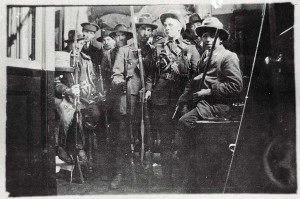Kindred Lines
Published in Features, Issue 2 (March/April 2016), Volume 24WO 35:
army in Ireland, administrative and Easter Rising
By Fiona Fitzsimons

(L to R): Desmond O’Reilly, James Mooney, Paddy Byrne, John Doyle, Tom McGrath, Hugh Thornton, John Joseph Twamly and Bernard Friel—one of the few photographs (taken by Joseph Cripps) of rebels inside the GPO at Easter 1916. In all probability most, if not all, feature in the WO 35 files. (NLI; additional information supplied by Lorcan Collins)
The index to the archival collection was also fairly rudimentary, placing further limits on research. An archivist in the UK National Archives in Kew once remarked to me that the easiest way to limit access to records wasn’t a restriction order but to list the collection so as to obscure content and relevance. These records contain probably the most comprehensive archival collection for the 1916 Rising and War of Independence in existence. For much of that time martial law was in effect, and the records include accounts of courts martial for thousands of insurgents and civilians. Courts-martial records for the 1916 leaders sentenced to death are held separately in WO 71. None for Éamon de Valera or Countess Markievicz have yet been found. Under martial law, habeas corpus was suspended and civilians could be lifted from the streets or their homes, evidence of which is contained in the files of ‘Enquiries as to the innocence of people detained in custody’.
The British reintroduced martial law in Ireland during the War of Independence. One of the key series contained in this sub-collection are the ‘Search and raid reports’, which contain the names, addresses and occupations (as well as other identifying information) of those arrested and houses searched, along with witness statements by the authorities. There are more files of ‘Arrests and court-martials’, and, chillingly, records of ‘Courts of enquiry in Ireland in lieu of inquests’. Daily accounts of the military and police response to insurgents are provided in separate ‘War Diaries’.
One box (WO 35/69) is especially topical, because it contains the main batch of British military records for the 1916 Rising. Included are not only courts martial but also a set of related files containing names and identifying information for civilian witnesses claiming expenses to attend them. Other series of interest to family and local historians include ‘Unarmed persons shot by the rebels’, which includes the names of and, in most cases, identifying information for civilians, but also of DMP and RIC constables. The ‘Reports of persons killed or wounded by rebels’ contain similar information but include even more names.
‘Daily situation reports’ provide the most comprehensive account of rebel activity in Ireland, and the military and police response it provoked from April to May 1916. The authorities kept files on the ‘Disposal of rebels’ property’ and the ‘Disposal of the printing press, machinery and type seized [from the GPO]’. A file of ‘Requests for mementoes of the Rising’ from individuals within the administration indicates a dim awareness that the Rising was a remarkable event.
The big story that the WO 35 records tell is the process by which the Irish population, initially hostile to the rebels in 1916, were alienated by the authorities’ heavy-handed response, so that by 1921 there was broad support for independence. Much of WO 35 is currently being digitised and indexed, and in April 2016 it will be published on-line on findmypast.com.
Courts-martial records for the 1916 leaders sentenced to death (WO 71) will be released this year by the National Archives of Ireland.
Further reading
B. Barton, Secret court martial records of the 1916 Easter Rising (Belfast, 2002).
D. Ferriter, A nation and not a rabble: the Irish Revolution 1913–1923 (London, 2015).
Charles Townshend, Easter 1916: the Irish Rebellion (London, 2006).
















